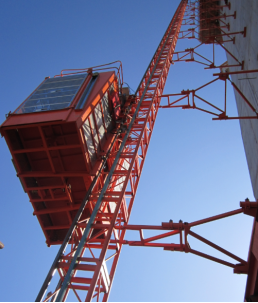Categories
Tags
-
#Elevator
#NORD Gearboxes
#Safety Devices
#Types of Hoists
#tower crane trolley
#Brake Disc for Tower Crane Motor
#Tower Crane Wire Rope Wear
#Tower Crane Trolley Mechanism
#Construction Hoist Safety Device
#Hoist in Construction Site
#GJJ Hoist
#Tower Crane
#Tower Crane Limit Switches
#Alimak Elevator Parts
#China Hoist Building Construction
#Hoist for Construction Materials
#Motor for Construction Hoist
#Tower Crane Wall Ties
#Understanding the Role of Brake Discs in Tower Crane Motors
#Common Hoist Gearbox Problems and How to Prevent Them
#Construction Material Hoist
#Suspended Platform Safety Lock
#CCKB Construction Hoist Spare Parts
#Hoist Motor
#ABB Inverter
#Tower Crane Mast Section
#Construction Hoist Mechanical Parts
#Suspended Platform
#Tower Crane Slewing Bearing
#Tower Crane Parts
#High Precision Gear Racks
#Construction Hoist Drive Parts
#Construction Hoist Gear Racks
#Cordless Snow Blowers
#Snow Blower
#Portable Gas Generator
#4000 Watt Inverter Generators
#Tiller
#Gas Tiller for Small Garden
Archives
Construction hoist safety devices and their functions
-
Construction hoist safety devices and their functions
Construction hoists are equipped with a complete set of safety protection devices to effectively prevent various safety accidents that may occur during equipment use. However, in actual use, various safety accidents are often caused by ignoring or directly shielding these safety devices. The following is an explanation of the safety devices on construction hoists and their functions.
1. Fall prevention safety device
(1) For the first use of a hoist or a hoist that has been reinstalled, a fall test with a rated installation load should be conducted when the guide frame is installed to 10.5 meters; a rated load fall test should also be conducted before the installation is completed and put into normal use; after the hoist is in normal operation, a fall test should be conducted every three months.
(2) The safety device is required to be sent to a qualified inspection agency for inspection every year, and can only be continued to use after passing the inspection. The inspection certificate is valid for 1 year. The safety device must be scrapped after 5 years of use.2. Overload protection device
(1) When the weight of the cargo in the cage reaches 90% of the rated load, the device will issue an audio alarm signal to remind the hoist operator to prevent the cage from being overloaded;
(2) When the weight of the cargo in the cage reaches 110% of the rated load, the device will cut off the control power of the cage to prevent the cage from operating overload.3. Anti-topping safety device
(1) There are a total of 4 anti-topping devices, namely upper limit, upper limit limit, topping limit and safety section.
(2) The first three are electrical limit-type anti-topping devices. When the cage reaches the set height position of the limit, the limit switch will act, the cage will be powered off, and stop at the rise.
(3) The safety section is a mechanical anti-topping device. The safety section is located at the top end of the guide frame. When the cage runs to this section, the cage cannot continue to rise.4. Anti-bottoming safety device
(1) There are a total of 2 limit devices, namely lower limit and lower limit limit.
(2) They are all electrical limit devices. When the cage descends to the set height position of the limit, the limit switch will act, the cage will be powered off, and stop descending.5. Anti-derailment safety device
(1) One type is a rollover prevention safety hook, which is mainly arranged on the main channel steel of the cage and trolley frame.
(2) One type is a safety hook to prevent the gear from disengaging from the rack, which is mainly arranged at the position of the gear relative to the safety plate and drive plate.6. Door lock device
(1) All doors on the hoist are equipped with electrical limit devices. When the door is opened or not closed properly, the cage will be powered off and unable to operate.
(2) The single door and the guardrail door are individually equipped with a mechanical interlocking device. The door can only be opened when the cage is in the correct position.
(3) The double door and the skylight door are also equipped with a mechanical locking device to ensure the safety of people in the cage during the operation of the cage.
